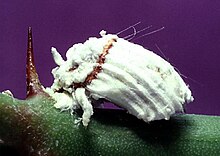Cottony cushion scale
| Icerya purchasi | |
|---|---|
 |
|
| Icerya purchasi , female | |
| Scientific classification | |
| Kingdom: | Animalia |
| Phylum: | Arthropoda |
| Class: | Insecta |
| Order: | Hemiptera |
| Suborder: | Sternorrhyncha |
| Superfamily: | Coccoidea |
| Family: | Monophlebidae |
| Genus: | Icerya |
| Species: | I. purchasi |
| Binomial name | |
|
Icerya purchasi Maskell, 1878 |
|
Icerya purchasi (common name: cottony cushion scale) is a scale insect that feeds on more than 50 families of woody plants, most notably on Citrus and Pittosporum. Originally described in 1879 from specimens collected in New Zealand as pests of kangaroo acacia, it is now found worldwide where citrus crops are grown. The cottony cushion scale originates from Australia.
This scale infests twigs and branches. The mature hermaphrodite is oval in shape, reddish-brown with black hairs, 5 mm long. When mature, the insect remains stationary, attaches itself to the plant by waxy secretions, and produces a white egg sac in grooves, by extrusion, in the body which encases hundreds of red eggs. The egg sac will grow to be two to three times as long as the body. Newly hatched nymphs are the primary dispersal stage, with dispersion known to occur by wind and by crawling. Early stage nymphs feed from the midrib veins of leaves and small twigs, and do the bulk of the damage. At each molt, they leave at the old feeding point the former skin and the waxy secretions in which they had covered themselves and from which their common name is derived. Unlike many other scale insects, they retain legs and a limited mobility in all life stages. Older nymphs migrate to larger twigs and eventually as adults to branches and the trunk. Their life cycle is highly temperature dependent, as the length of time in each stage of life is longer in cold temperatures than high temperatures.
In addition to the direct damage from sap sucking, the insects also secrete honeydew, on which sooty mold often grows and causes further damage to the host plant. Some ants will also consume this honeydew.
'It turns out that females in these hermaphrodite insects are not really fertilizing their eggs themselves, but instead are having this done by a parasitic tissue that infects them at birth,' says Laura Ross of Oxford University's Department of Zoology. ‘It seems that this infectious tissue derives from left-over sperm from their father, who has found a sneaky way of having more children by mating with his daughters.'
...
Wikipedia
